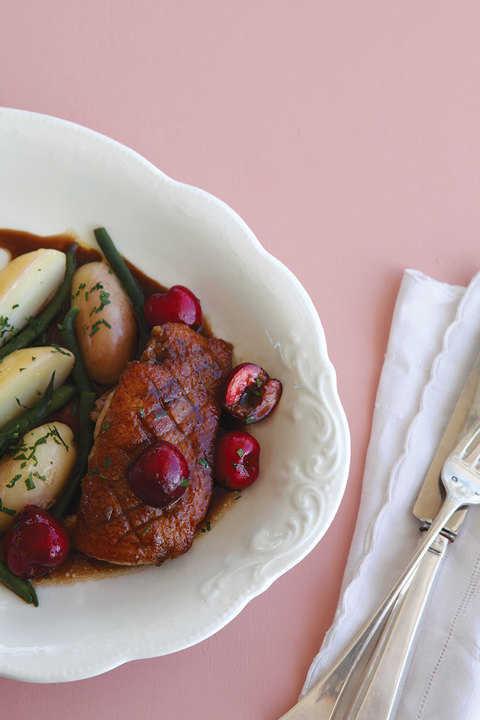14 December 2022
DUCK AND CHERRIES

HISTORY: This is from my Listener Column of 22 December 2012: CHERRIES
It’s cherry season. A true fruit of celebration, cherries appear in different cultures, where the promise of spring is heralded by the glory of a cherry tree in blossom. The Japanese are perhaps the most famous for honouring the cherry, as they picnic joyously under the bountiful, glorious blossoms. That tradition is one of the more significant seasonal observation a large population makes anywhere around the world. Here in New Zealand we mark the cherry blossom season with the grand annual parade in Alexandra.
The first cherries, harvested from Hawke’s Bay, arrived in the markets in late November. They were sweet, soft fruit, light red in colour and were best eaten fresh as they did not, like most cherries, have great keeping quality. As the cherry season progresses, a seemingly short period of eight to ten weeks that passes all too swiftly, we see later crops of more sturdy varieties in the markets.
Cherries are grown in Nelson, Marlborough, and of course Central Otago, producing a significantly large crop that is exported around the world. The most prized cherries tend to be crisper, darker and have those fabulously intense juices that stain everything in sight, including lips and teeth. Fabulous eaten fresh, the firm flesh of the later varieties makes them ideal for cooking too.
And even though the rich colour of dark-hued fruit appeals most, don’t overlook the fabulous varieties of white cherries. These are slightly misnamed as white cherries have pale yellow and coral coloured flesh with sweet yellow flesh. They are just as sweet and delicious as their cherry-coloured counterparts.
Anytime you’re invited somewhere special over the next few weeks and you want to take a gift that will be truly appreciated, consider a box of cherries, everyone’s favourite. Packed into 1kg or 2kg boxes, they can be found in all good supermarkets and specialty fruit and vegetable stores. You can also order them online from any number of growers, found easily by searching ‘cherries’ on the internet.
If cooking with cherries, it is well worth the effort to remove the stones. It’s quite a task to cut each cherry in half to find the stone, but can be made much easier by using a cherry pipper. This nifty little gadget punches through the cherry to push the stone out through the base. One of my all time favourite food writers, Jane Grigson suggests in her Fruit Book that stoning cherries “is a trying business so avoid pampering your family as half the fun of a cherry pie is putting the stones on the side of the plate and counting them out.”
Cherries go well in both sweet and savoury dishes. I immediately think ‘duck’ when I see fresh cherries, and if I want a sweet dish, some form of chocolate makes the perfect partner.
DUCK BREASTS WITH BALSAMIC, ORANGE & FRESH CHERRIES
*4 boned duck breasts *1 tsp salt *Freshly ground black pepper *1 small onion finely chopped *1 tbsp butter *Scant tbsp flour *300mls chicken stock *150mls red wine *1 orange, grated zest and juice *2 tbsps balsamic vinegar *20 cherries, stones removed and cut in half
Trim any excess flaps of fat from the duck breasts. With a very sharp knife score the skin of each duck breast to make a diamond pattern. Generously season each side with salt and pepper. Place the duck breasts, skin side down in a heavy based frying pan, and place over a moderate heat. There is no need to oil the pan as the fat will immediately start to run from the duck. Turn the heat to low and allow the duck to cook gently for about 10-12 minutes. Once the skin is crisp and golden turn the duck breasts over and continue to cook on the meaty side for a further 2 minutes. The meat should be nicely rare. Remove from the pan and keep the duck breasts covered in a warm place to rest for at least 5 minutes before serving. There will be at least one cup of fat in the pan, so store this in a container and when cool, refrigerate. The duck fat can be used to roast delicious potatoes and keeps for months if refrigerated. To make the sauce, put the chopped onion and butter in a small saucepan over low heat. Cook gently until the onion is golden and soft. Stir in the flour and continue to cook until the flour is golden. Add the stock, red wine, orange zest and juice and stir while bringing to the boil. to simmer for at least 10 minutes so it reduces and becomes syrupy. Add the balsamic and cherries and cook for a further minute. Allow the sauce To serve, place the duck breast on a heated plate and pour the sauce and cherries over each portion. Serve with steamed baby new potatoes and blanched baby green beans, garnished with a little chopped parsley. Serves 4 Wine match: a Central Otago pinot noir